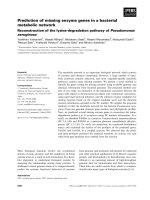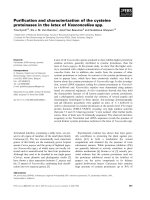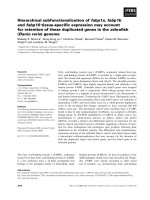Characterization of gli2 2b genes in zebrafish hindbrain development 3
Bạn đang xem bản rút gọn của tài liệu. Xem và tải ngay bản đầy đủ của tài liệu tại đây (1.23 MB, 85 trang )
Results
118
Fig.
3
-
14
gli2b
MO
blocks
zebrafish
gli2b
mRNA splicing
.
(A) Partial gli2b
genomic sequence used for designing splicing morpholino. Sequence
complementary to morpholino is underlined in red. Exons (gli2b cDNA:1125-1314,
1315-1425, 1426-1560 nt) are in cyan and introns are in black. Arrows indicate
primers showed in B. (B) Diagram shows the strategy of using splice MO (Red bar)
for blocking the normal splice site and organization of predicted mRNA. The blue
and green arrows represent the primers for PCR used to test whether the splice MO
affects formation of gli2b mRNA. The sequences for primers F1, F2, R2 are
indicated in A; R1 is indicated in Fig. 3-2. (C) RT-PCR results. Control RNA (lane
C) was extracted from gli2bMMS morphants; morphant RNA (lane M) was
extracted from gli2bSPL. Primers used are indicated in B. EF1α primers were used
for internal control of mRNA quality.
Results
119
3.4.2 Classification of phenotypes of gli2b morphants
Both the gli2bATG and gli2bSPL morphants showed similar morphological
changes. Compared with wild type or control MO injected embryos, gli2b morphants
demonstrated dosage-dependent phenotypes (Table 3-1). The mild phenotype (Type I)
of gli2b morphants consisted of the enlarged hindbrain ventricle and smaller brain and
eyes by 48 hpf (Fig. 3-15C, D). The severe phenotype (Type II) of gli2b morphants
demonstrated also abnormality of the trunk and in ~50% cases conversed otoliths at
48 hpf (Fig. 3-15E, F). Interestingly, after injection of a high dose (>2 pmol) of gli2b
MO, a defect of the convergence-extension movement could be observed. By the end
of gastrulation these morphants showed a phenotype similar to that of mutants with
affected BMP signaling (Fig. 3-15 H, I), indicating that the early function of Gli2b
might be related to dorso-ventral (D-V) patterning. This early function may be due to
maternal expression of this gene and not Hh related. Therefore, to circumvent the
early defect and investigate the function of gli2b in neural development, we typically
injected embryos with the almost 10 times lower dose of morpholino (0.3 pmol).
Results
120
Table 3-2 Phenotypes obtained after injection of gli2b morpholino
oligonucleotides in zebrafish embryos.
gli2bAtg MO
injected(pmol)
Injected
number
Mortality
>24hpf(Num/percentage)
Looks
normal
Mild
phenotype
Strong
phenotype
0.15 100 12(12%) 28(28%)
54(54%)
6(6%)
0.3 100 15(15%) 13(13%)
49(49%)
23(23%)
0.6 50 7(14%) 5(10%)
17(34%)
21(42%)
1 100 35(35%) - 11(11%)
54(54%)
1 gli2bMMA
50 3(6%) 45(94%)
2(4%) -
gli2bSpl MO
injected(pmol)
Injected
number
Mortality
>24hpf(Num/percentage)
Looks
normal
Mild
phenotype
Strong
phenotype
0.15 100 8(8%) 46(46%)
43(43%)
3(3%)
0.3 100 7(7%) 18(18%)
61(61%)
14(14%)
0.6 100 13(13%) 7(7%)
52(52%)
28(28%)
1 100 18(18%) - 33(33%)
49(49%)
1 gli2bMMS 50 2(4%) 48(96%)
- -
Results
121
Fig.
3
-
15
Classification of
G
li2b
morphants.
(A-F) Gli2b morphant with mild
phenotype (Type I) and severe phenotype (Type II) at 30 hpf and 48 hpf. The mild
phenotype (C, D) of Gli2b morphant is characterized by an enlarged hindbrain
ventricle but relatively normal trunk. The severe phenotype (E, F) of Gli2b morphant
shows not only enlarged hindbrain ventricle, but also curled trunk. (H, I) gli2b
morphants in high doses (dose I, 1 pmol; dose II, 1.5 pmol) showed
convergence-extension defects (arrows) in different levels compared with control
(G).
A
B
C
E
F
D
G
H
I
Results
122
3.4.3. Comparison of the phenotypes of gli2 and gli2b morphants
Both the gli2b and gli2 morphants by 48 hpf were characterized by the similarly
enlarged 4
th
ventricle and smaller brain and eyes (Fig.3-16B, C). Further analysis of
the Gli2b morphant under the differential interference contrast (DIC) microscope
showed the intact horizontal myoseptum in contrast to Gli2 morphants, which lacked
this structure (Fig.3-16E,F; 45/52 embryos). Even when injected with the much higher
doses of MO (1 - 2 pmol), the gli2b morphants acquired the curl-down tail phenotype
with much more severe abnormality of the brain, but preserved the horizontal
myoseptum. gli2b is not expressed in the adaxial slow muscle cells, thus in muscle
development gli2b probably plays a minor role if any. In contrast, both gli2 and gli2b
show similar late expression in the hindbrain and its deficiency in morphants is in line
with expression of these genes in this part of brain.
ctrl/brain
gli2b
MO/brain
gli2
MO/brain
ctrl/trunk
gli2b
MO/trunk
gli2
MO/trunk
A
B
C
E
F
D
Fig.
3
-
16
Comparative
analysis of
G
li2b and
G
li2
morphants.
Both Gli2b and
Gli2 morphants show similar abnormality in the hindbrain but the trunk is affected
differently. Gli2b (B) and Gli2 morphants (C) have enlarged fourth ventricle
(arrowhead). In the trunk of Gli2b morphant (E) the horizontal myoseptum (arrow) is
normal (D), while in Gli2 morphant the horizontal myoseptum is abnormal and
somites U
-
shaped (F).
Results
123
3.4.4 Gli2b morphant showed cell proliferation defects in the hindbrain
In the 30 hpf hindbrain, the radial astrocytes (RA) stained with zrf-1 antibody
appeared as seven double segmental clusters that form curtains along rhombomere
boundaries (Trevarrow et al, 1990) (Fig. 3-17A) (for discussion of characteristics of
cell types, see Morest and Silver, 2003). These clusters were reduced in Gli2b
morphants (Fig. 3-17B; 10/10 embryos). Further increase of gli2b MO dose led to
decrease of zrf-1 staining at this stage, but a gross morphology of morphants remains
relatively normal (not shown). Perhaps, elimination of RAs could be due to apoptosis
in the hindbrain triggered by the knockdown of Gli2b . However, TUNEL staining of
Gli2b morphants failed to detect increase of apoptosis (data not shown). Another
possibility is that cell proliferation slowed down. Consistent with this explanation, the
number of mitotic cells detected by the anti-phospho-histone H3 (P-H3) antibody was
reduced in the hindbrain both dorsally in the ventricular zone (VZ) and ventrally in
association with RGCs (Fig. 3-17C, D). Our analysis of the number and distribution
of proliferating cells in the consecutive sections of the hindbrain of Gli2b morphants
and controls (n=3, sections/embryo=15) demonstrated moderate reduction of cell
proliferation in the ventricular zone and more significant reduction in the ventral
hindbrain (Fig. 3-17E). Since the RAs are the neural progenitors, these results
indicated that Gli2b could be necessary in the progenitor cells, including the neural
progenitors in the hindbrain.
Results
124
Fig
. 3
-
17
gli2b
and cell
proliferation.
(A, B) Whole mount immunostaining of
radial astrocytes in 30 hpf control (A) and Gli2b morphant (B) by zrf-1 antibody
followed by POD staining. (C, D) Cross sections of 30 hpf control (C) and Gli2b
morphant (D) at the hindbrain level stained by anti-P-H3 (purple) and zrf-1 (green)
antibody. (E) Chart shows the average number of proliferating cells in the ventricular
zone of 4th ventricle and the ventral region associated with processes of RA cells in
continuous sections of hindbrain of Gli2b morphant and wild type embryos.
Ventricle RA
Results
125
3.4.5 zath3 expression was affected in Gli2/Gli2b morphants
Since expression of gli2b takes place in the CNS (Ke et al, 2005) and Gli2b
knockdown caused abnormality of cell proliferation and differentiation, we decided to
check markers of early neurodifferentiation. zath3 (neurod4) is involved in early
neurogenesis downstream of ngn1 (Bae et al, 2003; Park et al, 2003; Wang et al,
2003). zath3 detects two main groups of cells. First, the looped clusters in the
hindbrain consist of cell groups extended along the D-V axis; these are associated
with curtains of RAs on both sides of rhombomeric boundaries (DV clusters) (Fig.
3-18A). Second, the ventral (V) clusters in a central part of rhombomeres 2, 3, 4 and 6
(Fig. 3-18C). In the single Gli2 and Gli2b morphants, the dorsal extent of zath3
expression in the DV clusters is shifted more ventrally (Fig. 3-18B, E), while the V
clusters diminished (Fig. 3-18D, E; 10/10 embryos each). In the double Gli2/Gli2b
morphants, zath3 expression in the DV clusters is strongly reduced; however, some
zath3 transcripts were still detected ventrally in rhombomeres 3 and 4 (Fig. 3-18F;
10/10 embryos). Thus it seems that in both positions Gli2b acts in parallel with Gli2,
but at different D-V levels zath3-positive cells demonstrate different dependence on
Gli2 proteins.
To get better understanding of this phenomenon, we checked expression of zath3
in two mutants affecting Hh pathway. In yot
-/-
, where in result of mutation the
dominant repressor form of Gli2 (Gli2
DR
) appeared (Karlstrom et al, 1999), the
expression of zath3 in the DV clusters was similar to that in control. In contrast, the V
clusters in rhombomeres 2 and 3 disappeared and the ectopic domain of zath3
expression in rhombomere 5 appeared (Fig. 3-18G). In smu
-/-
mutant deficient in the
receptor of Hh signaling, Smoothened (Chen et al, 2001; Varga et al, 2001), the
zath3-positive DV clusters were intact while all V clusters disappeared (Fig. 3-18I).
Results
126
Similar result was obtained after Gli2b knockdown of Gli2b on a yot
-/-
background
(Fig. 3-18H; 10/10 embryos). Hence, it seems that Hh-dependent Gli2 activating role
is required for expression of zath3 only in the ventral hindbrain probably containing
more differentiated neurons. Here some other factors may also be involved in addition
to the two Gli2s. In the dorsal hindbrain, the maintenance of neuroblasts could be due
to the repressive role of Gli2 (Dai et al, 1999; Ruiz i Altaba, 1999; Sasaki et al, 1999).
Alternatively, Gli2s may act within a context of dorsal signaling other then Hh. In
both models Gli2b seems acts in parallel with Gli2.
Results
127
Results
128
Fig. 3
-
18
Gli2/
Gli2b
regulate expression of
zath3.
zath3 expression in
hindbrain in 30 hpf in controls (A,C,E,G,I) or Gli2b MO. injected embryos (B, D,
F, H,J). White broken lines indicate the r4. (A,C) control; (B,D) Gli2b morphant;
(E) Gli2 morphant; (F) Gli2/Gli2b morphant; (G) yot
-/-
mutant; (H) yot
-/-
mutant/Gli2b morphant; (I) smu
-/-
mutant; (J) smu
-/-
mutant/Gli2b morphant. Black
lines indicate the zath3-positive clusters in the ventral hindbrain. Abbreviation: e,
ear; r4, rhombomere4
Results
129
3.4.6 Gli2/2b and regulation of expression of bmp2
The bone morphogenetic proteins (BMPs) play roles in specifying the dorsal
neural tube (Dickinson et al, 1995; Liem et al, 1995; Kodjabachian et al, 1999), while
ventrally their activity is antagonized by Hh signaling (Goulding et al, 1993; Roelink
et al, 1994). In the dorsal aspect of neural tube Gli2 and 3 were shown to act as
repressors of Hh targets (Aza-Blanc et al, 2000; Meyer and Roelink, 2003; Ruiz i
Altaba, 1999; Sasaki et al, 1999; von Mering and Basler, 1999). The double
knockdown of Gli2/Gli2b caused the reduction of ventralizing Hh signaling and
affected the dorsal expression of zath3. This could be reflected in changes of
transcription of dorsalizing factors. We tested the relative expression level of bmp2a,
bmp2b and bmp4 mRNA in 28 hpf gli2/2b morphants by the quantitative Real-Time
PCR (Fig. 3-19). Total RNA extraction from 50 embryos per sample was carried out
in two different batches of experiments and Real-Time PCR was carried out in
triplicates for each sample. It showed that in Gli2/Gli2b morphants all bmp genes
were expressed at much higher level. The increase of bmp2b expression was higher
than that of bmp2a or bmp4. These results illustrated a role of the two zebrafish Gli2
in antagonizing BMP signaling at a distance from the source of Hh signaling.
Therefore, bmp’s could be amongst targets repressed by Gli2s in the dorsal brain.
Results
130
Relative amount of mRNA in
G
li2/2b
morphants (MO) compared to that in
Wild type (WT) embryos
Fig.
3
-
19
G
li2b
and expression of
bmps
.
Total RNA was extracted from 50
Gli2/2b morphants or wide type embryos. RT-PCR was carried out in triplicate for
each sample. The experiment was repeated once more.
0
1
2
3
4
bmp2abmp2bbmp4
WT
MO
Results
131
3.4.7 Inhibition of gli2b caused the disruption of notch1 and gfap expression
Notch signaling is known to maintain the neural progenitor fate and facilitate the
glial differentiation (reviewed by Wang and Barres, 2000). The activity of Notch1
leads to strong activation of Her4 resulting in suppression of expression of
neurogenin1 transcription and reduction of the number of primary neurons (Takke et
al, 1999). Since the knockdown of gli2b affects the neural progenitors in the hindbrain,
we would like to examine whether this event was due to the disruption of Notch
signaling.
notch1a was expressed in the hindbrain forming lateral loops and the intermediate
medio-lateral clusters where expression was higher then laterally (Fig.3-20A). In
gli2b morphants, notch1a expression was reduced in the whole hindbrain (Fig.3-20B).
The lateral loops disappeared; the intermediate medio-lateral clusters were
substantially reduced (Fig. 3-20B; 10/10 embryos). notch1b was expressed similar to
that of notch1a but it did not formed the intermediate medio-lateral clusters, whereas
its expression was enhanced at the midline (Fig. 3-20C). In gli2b morphants, the
lateral loops were also absent, but the midline notch1b expression remained albeit at
much more reduced level (Fig. 3-20D; 10/10 embryos). Similarly expression of one
more marker linked to gliogenesis, gfap was substantially reduced at the midline
while strongly reduced in lateral loops (Fig. 3-20G, H; 10/10 embryos). In summary,
the expression of two notch genes was dramatically reduced in the lateral hindbrain,
but less so medially. This illustrated differential requirement in Gli2b along the M-L
axis of the neural tube.
The neural differentiation marker, neurogenin1 (ngn1), is expressed in position
that corresponds to that of the intermediate medio-lateral clusters of notch1a. Similar
to this marker expression of ngn1 was slightly affected in gli2b morphants (Fig. 3-20E,
Results
132
F; 10/10 embryos). Since Ngn1 acts as a proneural gene, the intermediate mediolateral
clusters of cells expressing Ngn1 could represent neuronal precursors. In contrast, the
midline expressing gfap and notch1b and the lateral loops, expressing notch1a and 1b,
could represent the two different populations of non-neuronal precursors. The severe
disruption of these and decrease in expression of zrf-1 antigen indicate much more
severe decrease in early gliogenesis comparing to that of neurogenesis. Thus, Gli2b in
the hindbrain may act preferentially in regulating early differentiation of non-neuronal
cell lineages.
Results
133
Fig. 3-20 Expression of early neurodifferentiation markers in the hindbrain of
Gli2b morphant at 30 hpf. (A, B) Expression of notch1a in Gli2b morphant (A) and
control (B). (C, D) Expression of notch1b in Gli2b morphant (C) and control (D). (E,
F) Expression of ngn1 in Gli2b morphant (E) and control (F). (G, H) Expression of
gfap in Gli2b morphant (G) and control (H). The relative positions of expression
domains are indicated in left side of the panel: midline, blue bar; intermediate
medio-lateral cluster, green bar; lateral loops; red bar.
Results
134
3.4.8 Inhibition of gli2b did not affect the segmentation of hindbrain
Since loss-of-function of Gli2b caused the disruption of segmented
notch1a/notch1b expression, it is interesting to examine whether this is due to the
disruption of the rhombomere segmentation in hindbrain. In the zebrafish, several
genes, including krox20, hox genes and valentino (val), are used as markers to
ascertain a proper course of hindbrain segmentation (Moens et al, 1996; Oxtoby et al,
1993; Prince et al, 1998). krox20 and val may regulate hox gene expression in specific
segment patterns in hindbrain, and hox genes establish identity of individual segments.
Therefore, expression of these genes in both uninjected controls and Gli2b morphants
was compared. As shown in Figure 3-21A-H (10/10 embryos each), there was no
difference between the expression of these markers in control embryos and that in
Gli2b morphants, indicating that Gli2b is not involved in either the early onset of
segmentation or the later maintenance of specific identity of rhombomeres.
Results
135
Fig.
3
-
21
Expression of
segmentation
markers
in Gli2b morphants
.
(A,B)
Expression of val in r5 and r6 in control (A) and Gli2b morphants. (C, D) Expression
of krox20 in r3 and r5 in control (C) and Gli2b morphants (D). (E, F) Expression of
hoxa2 in r2-r5 in control (E) and Gli2b morphants (F). (G, H) Expression of hoxb3 in
r5
-
7 in
control (G) and Gli2b morphants (H).
Results
136
3.5 Characterization of the gli2/gli2b function within Hh pathway
The activities of Gli transcription factors are regulated by Hh signaling. Gli
proteins are responsible for regulating the expression of Hh-downstream genes
(reviewed by Ingham and McMahon, 2001). In Drosophila, the single Gli homolog,
Cubitus interruptus (Ci) has potential activator or repressor function in Hh signaling,
depending on the posttranslational modifications in the presence or absence of Hh. In
vertebrates, a sum of activities of all Gli proteins is supposed to regulate all
Hh-related activities in vertebrates. For example, while in absence of Hh Gli2 acts as
repressor of Hh targets, in presence of Hh, Gli2 is supposed to be the Hh-dependent
activator; this is supported by down-regulation of Hh target genes in mouse Gli2
mutants (Ding et al, 1999; Ruiz i Altaba, 1999).
However, a functional analysis of Gli2 functions in different vertebrate model
animal provided evidence that during evolution functions of Gli2 could vary. For
example, knockdown of Gli2 in the zebrafish resulted in a relatively minor defect of
Hh signaling (Karlstrom et al, 2003), which could be due to existence of a second
gli2-related gene (gli2b) identified in our study (Ke et al, 2005). Therefore, it is of
interest to find specific developmental roles of the two Gli2. The aim of the following
sections is to understand how exactly gli2b and gli2 are involved in regulating events
of Hh signaling and which events they regulate. For this purpose, several zebrafish
mutants affecting Hh signaling (smu and yot) in combination with gli2b
loss-of-function experiments by morpholino knockdown were used. To evaluate
effects of experimental interference several known markers regulated by Hh (nkx2.2,
islet1 and netrin1) were used for WISH or immunohistochemistry analysis.
3.5.1 gli2b and nkx2.2 expression
Nkx2.2 is regulated by Hh signaling pathway and used as marker to define the p3
Results
137
neural precursors in ventral neural tube, which are located in the most ventral region
just above floor plate. P3 cells give rise to V3 interneurons in mammals (Briscoe et al,
1999). In cyclops (cyc
-/-
) mutants, which initially lack neuroectodermal expression of
shh, the expression of nkx2.2 is absent. And overexpression of shh mRNA results in
the ectopic expression of nkx2.2 (Barth and Wilson, 1995). Thus, it could be
informative to check whether Gli2b regulates nkx2.2 expression.
In Gli2b morphant, nkx2.2 expression only slightly expanded (Fig.3-22A, B; 5/5
embryos). In Gli2 morphant, nkx2.2 expression was similar to that in Gli2b morphant
(data now shown). These results indicated a minor role of both gli2 and gli2b in
regulating expression of nkx2.2 in the ventral hindbrain. Due to duplication of gli2 in
zebrafish, the function of Gli2b might be redundant with Gli2. Thus, loss of a single
Gli2 might not be enough to affect the Hh signaling in ventral hindbrain. To address
whether deficiency of both Gli2 and Gli2b would affect nkx2.2 expression, we
checked its expression after knockdown of both Gli2b and Gli2, but no obvious
difference has been found compared with single Gli2 or Gli2b morphants (data not
shown). Possibly Gli2s of zebrafish does not regulate the nkx2.2-positive ventral cells,
or other Gli members function redundantly with Gli2s in regulating these cells.
In yot mutant, mutation causes truncation of Gli2 and formation of the
dominant-negative (DN) Gli2 lacking C-terminal activator domain. This protein acts
as a constitutively active (CA) inhibitor of Hh signaling (Karlstrom et al, 1999).
nkx2.2 expression in yot
-/-
was maintained only in r4 (Fig.3-22C). Thus, while
CA-DN-Gli2 blocked Hh signaling in almost all ventral hindbrain the residual activity
of some other Gli could be responsible for maintaining nkx2.2 expression in r4.
It was proposed that r4 plays an important role of the signaling center within a
hindbrain (Maves et al, 2002). Hence it could be of interest to study a role of Gli2b in
Results
138
this rhombomere. The expression of nkx2.2 was completely lost in the hindbrain after
injection of Gli2b MO into yot
-/-
(Fig.3-22D; 5/5 embryos). This phenotype is similar
to that of smu
-/-
mutants deficient in Hh signaling (Fig.3-22E). These results indicate
that Gli2b in parallel with some other Gli plays a role in regulation of expression of
nkx2.2 in r4. As such Gli2b could be one of the factors necessary to establish r4 as a
regional signaling center within a hindbrain. In this regard, the function of Gli2b is
clearly different from that of Gli2. Importantly, this function of Gli2b was not
predicted based on expression pattern of this gene. It seems that Glis other than Gli2s
are necessary for induction of nkx2.2 expression in other rhombomeres.
Fig. 3-22 Gli2/Gli2b regulate nkx2.2 expression in the hindbrain at 30 hpf, dorsal
view. (A) Midline expression of nkx2.2 in wild type. (B) nkx2.2 expression in Gli2b
morphant. (C) In yot
-/-
mutant, nkx2.2 expression is maintained only in r 4 (arrow). (D)
yot
-/-
mutant injected with Gli2b morpholino, the expression of nkx2.2 was completed
lost in the hindbrain, which is similar with the expression pattern of nkx2.2 in smu
-/-
mutant
(E).
Results
139
3.5.2 Inhibition of Gli2b caused abnormal development of oligodendrocytes
The oligodendrocytes derive from the ventral neural progenitors, which express
olig2 (Lee et al, 2005; Park et al, 2002). The Hh signaling is both necessary and
sufficient for induction of oligodendrocytes in the spinal cord of vertebrates (Pringle
et al, 1996; Poncet et al, 1996; Orentas et al, 1999; Alberta et al, 2001; Soula et al,
2001). Given a role of Gli2b within a context of Hh signaling in the ventral neural
tube, it may be necessary for development of oligodendrocytes. After knockdown of
Gli2b, the morphants showed a decrease or even complete loss of olig2 expression in
the ventral hindbrain (Fig. 3-23A, B; 9/10 embryos). In contrast, expression of olig2
in the spinal cord of Gli2b morphant only slightly decreased compared with controls
(data not shown).
The embryos of ET3 transgenic GFP line (Parinov et al, 2004) express GFP in
position of olig2 expression in the ventral neural tube suggesting that
oligodendrocytes in these embryos could be GFP-tagged. Since mbp transcripts are
expressed in oligodendrocytes (Brosamle and Halpern, 2002), we used the anti-mbp
probe for double staining of the ET3 embryos against mbp mRNA and anti-GFP
antibody to detect GFP protein expression. The mbp probe stains the perinuclear space
(blue), while GFP was distributed evenly in the cytoplasm (brown). There are many
positive cells in the ventral part of the neural tube and detailed analysis of
colocalization of these two markers in this part of neural tube needs to be done on
cross sections. This was not necessary in this study, since the colocalization of mbp
and GFP is more obvious in the dorsal neural tube, where only a few cells expressing
these markers were detected at this stage (Fig. 3-23C, D). Thus, a population of
GFP-positive cells in the ET3 represents oligodendrocytes.
By 4 dpf, ET3 larvae expressed GFP in the hindbrain (Fig. 3-23F) and ventral spinal
Results
140
cord (Fig. 3-23G). The Gli2b morphants demonstrated substantial reduction of GFP
expression in the hindbrain (Fig. 3-23I; 19/21 embryos) and posterior trunk (Fig.3-23J;
16/21 embryos) while expression in the anterior trunk was much less affected (not
shown). Why such differential sensitivity in respect of Gli2b exists along the A-P axis
is currently unclear. One possibility is that at different A-P level cells require specific
levels of Gli2b, second, the population of GFP positive cells cells contains
oligodendrocytes and some other as yet unknown cell type, third, at different A-P
levels distribution of functions between proteins of Gli family may vary or these
proteins may have different origin (maternal v. zygotic). For further details to be
understood this analysis in future needs to be continued.
Results
141
Results
142
Fig.
3
-
2
3
gl
i
2b
is required for differentiation of oligodendr
ocytes
.
olig2
expression in hindbrain in 30 hpf control (A) and gli2b morphant (B). In the ET3 line
GFP maps oligodendrocytes as shown by double staining of anti-GFP antibody and
antisense mbp probes [C, representing the white frame in (E)]. Enlarged (D) from the
black frame in (C) reveals the mbp mRNA (blue, arrows) in GFP expressing cells
(brown). (E) Control embryos of ET3 line and ET3 Gli2b morphants (H). 4 dpf ET3
controls, hindbrain (F) and posterior trunk (G). GFP expression in the ET3 Gli2b
morphant, hindbrain (I) and posterior trunk (J).









